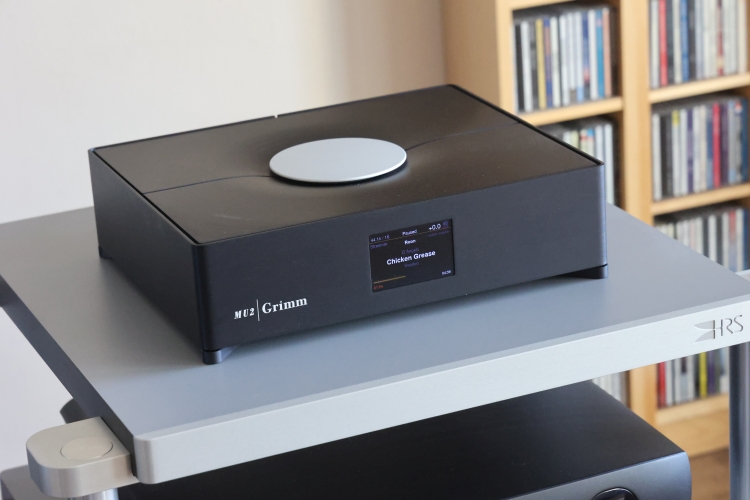
Review sample provided by Grimm Audio
Retail price including VAT:
No internal storage: €17.999
Available SSD storage: 2 TB (€240) / 8 TB (€640)
Other storage sizes on special request
When I reviewed the original MU1 in 2021, I instantly became a fan, and the server has been a central part of my system ever since. A few years later, I was informed that another server was being developed and would be a groundbreaking product. With the MU1 being so great, what would set the new product apart? Of course, that new product is the MU2 Streaming DAC and Media Player, and as it turned out, they are similar, yet different. And that is both comforting and exciting.
Principally, the MU2 does not deviate all that much from the MU1, which is a good thing! But instead of relying on active digital speakers or an external DAC, the MU2 includes the company’s proprietary ‘Major’ DAC and a relay-based analog preamp section. This allows the designers total control over the front end and provides customers with a simple, single-unit, easy-to-use central audio system hub.
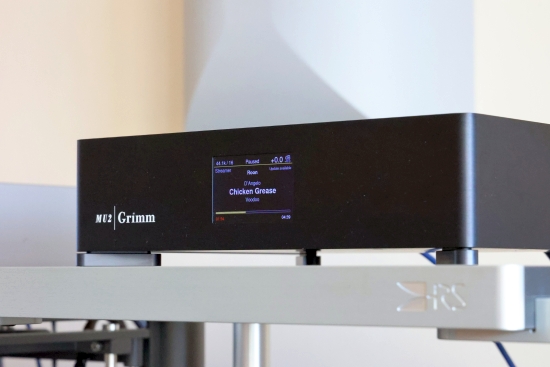
MU2 Streaming DAC and Media Player
The MU2 combines the functions of several components, including a Roon Server and Roon Endpoint, with internal SSD storage capability, a DAC and Master Clock, a Preamplifier with both digital and analog inputs, and analog volume control.
The MU2’s main music source is a Roon Core, Server, and End Point that offers playback from local files network files as well as streaming music via Tidal and Qobuz. You can stream from the MU2 to any other Roon endpoint from any brand, even multiple endpoints simultaneously.
Functionally, so far, the MU2 works just like the MU1. What differentiates it from the MU1 is that it combines its excellent server and streamer sections with an all-new Grimm-proprietary ‘Major’ DAC, a dedicated FPGA processor board with the highest possible quality in analog – and digital signal processing and dejittering, and an analog preamp with relay-based, analog volume control. Besides Roon, the MU2 offers two analog inputs and three digital inputs. There’s one balanced XLR input and one analog RCA input for analog, and TOSlink, RCA/Coax, and AES/EBU for digital. Analog outputs are available on RCA and XLR, and there’s even a 6,3 mm headphone output. Thus, the MU2 can function as a compact and beautiful yet very complete central hub in an audio system.
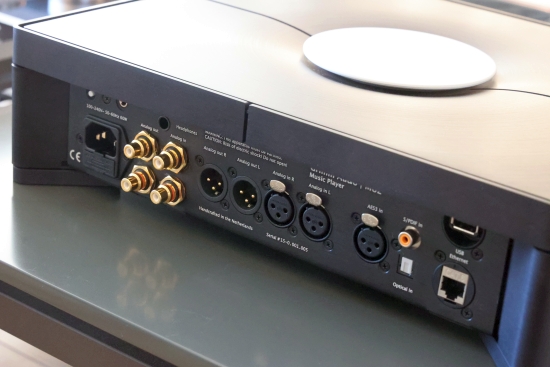
Key Technical Aspects
The MU2 is powered by in-house-designed switch mode power supplies that are clean and powerful and in-house designed voltage regulators (series and shunt type) to offer extremely high electrical isolation of sensitive circuit parts. The audio file and streaming functions are offered by Roon Labs software. The operating system is Tiny Core Linux. Grimm Audio has developed most of the other software that runs in the MU2.
On board is an exceptionally low jitter clock oscillator that is guaranteed accurate since each is measured with a proprietary jitter analyzer before it leaves the factory. Further, the MU2 employs an extremely powerful FPGA processor with highly sophisticated upsampling and noise-shaping algorithms.
The preamp section has an analog audio signal path that is Class A throughout, focusing on ultra-low harmonic distortion and ultra-low phase modulation. The relay-based analog volume control lets the user control external analog sources equally well as digital and internal sources.
The MU2 is intended to be used by the entire family. Its compact single-box design can easily be placed in any environment. The push/rotary dial on top offers a lot of functionality, while remote control is possible via Roon, a web interface, and any IR remote handset. An IR receiver unit is included with a cable that plugs into the back of the MU2.
Driven to keep improving, Grimm Audio works actively to provide ongoing updates. Whenever they improve the sound quality or enhance the feature set of the MU2, these improvements are offered to all existing customers via software or hardware updates (when possible). Software updates are free and can be installed automatically via the update server.
Finally, in case of a malfunction, the Grimm Audio Support Team is dedicated to getting you to enjoy the music again within the shortest timeframe possible. Grimm Audio offer a 5 year limited warranty to customers who fill in their warranty card.
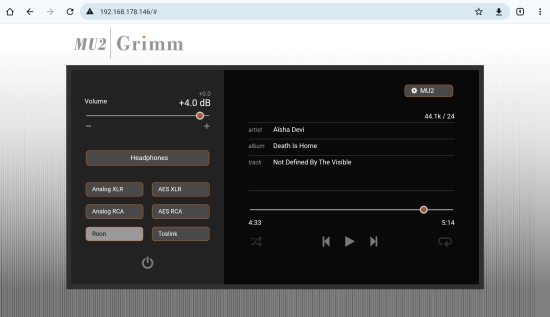
Above: main web screen of the Grimm Web Interface, reachable by simply typing the unit’s IP address in a browser window.
If you need to know the unit’s IP Address, here are two tips: Roon shows the IP address in its settings general section, and the MU2 also shows its IP address on its front panel display on the second screen of the menu.
Below: various Web Interface menus and settings.
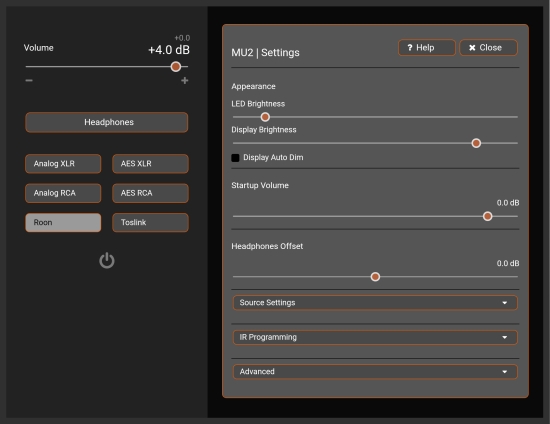
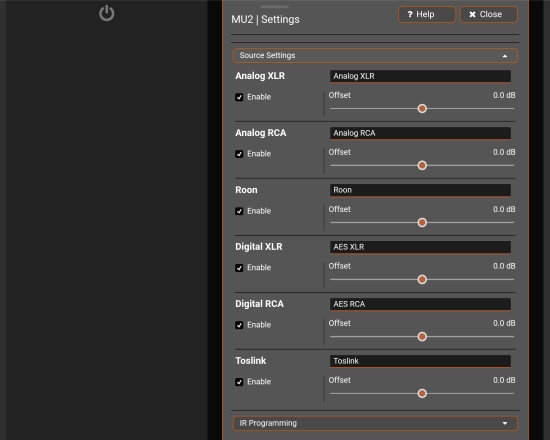
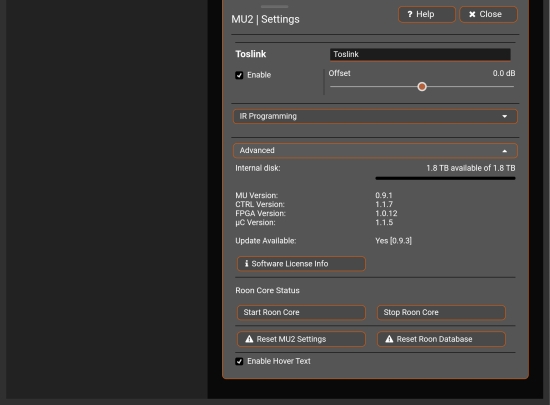
Major DAC
Grimm Audio’s proprietary Major DAC is a discrete 1.5-bit PWM converter that runs on the FPGA processor. It has a discrete design that combines the company’s Pure Nyquist upsampling filters with a “fundamentally flawless” 11th-order noise shaper of 1.5 bits. Grimm Audio have published interesting white papers, including one covering their “Pure Nyquist” filters. For this, please head to the Grimm MU2 page and see the Downloads tab.
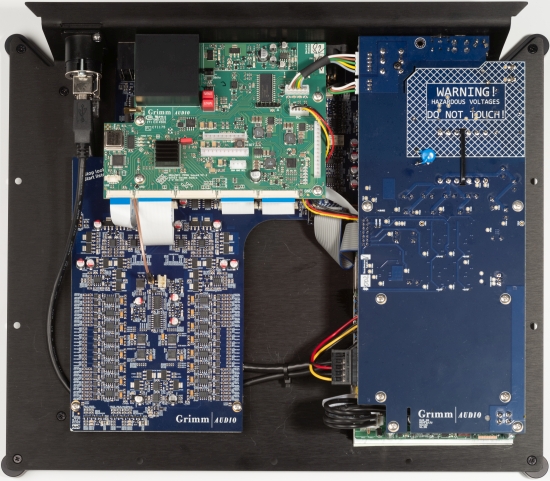
For this review, I’d like to focus on the DAC itself. The following is a simplification of the information found in the Grimm Major DAC document, which can also be found in the aforementioned downloads section.
Creating a high-quality analog signal from a digital signal has always been a challenge for any manufacturer. Companies have tried various approaches, including using “discrete DAC” methods to achieve better results. After three years of work, Grimm Audio developed a unique digital-to-analog converter using a combination of FPGA pre-processing and their own discrete DAC hardware.
Existing DAC techniques use multi-bit, bitstream, or PWM conversion. The conventional multi-bit conversion demands extreme precision, making achieving more than 18-bit precision difficult. These types of DACs show distortion and cross-talk, causing graininess or harshness in sound character.
To get around these problems, Philips introduced the ‘bitstream’ single-bit technology in the 80s, later used for SACD as the ‘DSD’ format. Single-bit DAC is inherently linear, but it can only represent two signal levels, causing a high noise level. The technique works by quickly switching the single-bit value through oversampling and then pushing the high noise away from the audio band into the inaudible region above 20 kHz using a noise shaper. This process brings challenges to a DA converter, such as more stringent requirements on clock jitter performance and significant high-frequency energy on the DAC output. Additionally, digital noise shaper systems operate with limited stability, compromising transparency and audible coherence.
A PWM DAC overcomes the disadvantages of single-bit architecture by using multiple bits and varying the width of the single-bit stream. However, a noise shaper is still required and demands extreme processing power, resulting in a compromised implementation and sound quality.
The MU2 ‘Major DAC’ threads the theoretical optimal middle ground between all these options. It uses a 1.5-bit architecture, meaning amplitude linearity is inherently guaranteed as the 1.5-bit value is represented with a single-bit D/A cell in ‘PWM style.’ Just as with PWM DACs, the noise shaper runs with an effectively constant efficiency, realizing a linear operation over the entire dynamic range.
The input of the noise shaper is fed from the extreme precision “Pure Nyquist” digital FPGA filter, running at 128 times the base rate, which results in a zero error operation of the noise shaper. Moreover, the 1.5-bit DAC choice offers such a stable noise-shaping operation that it allows for a highly optimized, unique 11th-order noise shaper.
Finally, the Major DAC uses a 16-cell FIR DAC topology per channel to filter high-frequency noise before entering the analog signal path, which is implemented fully symmetrically using high-quality components and a relay-based volume control section.
Next: Running In, Review Context, and Listening
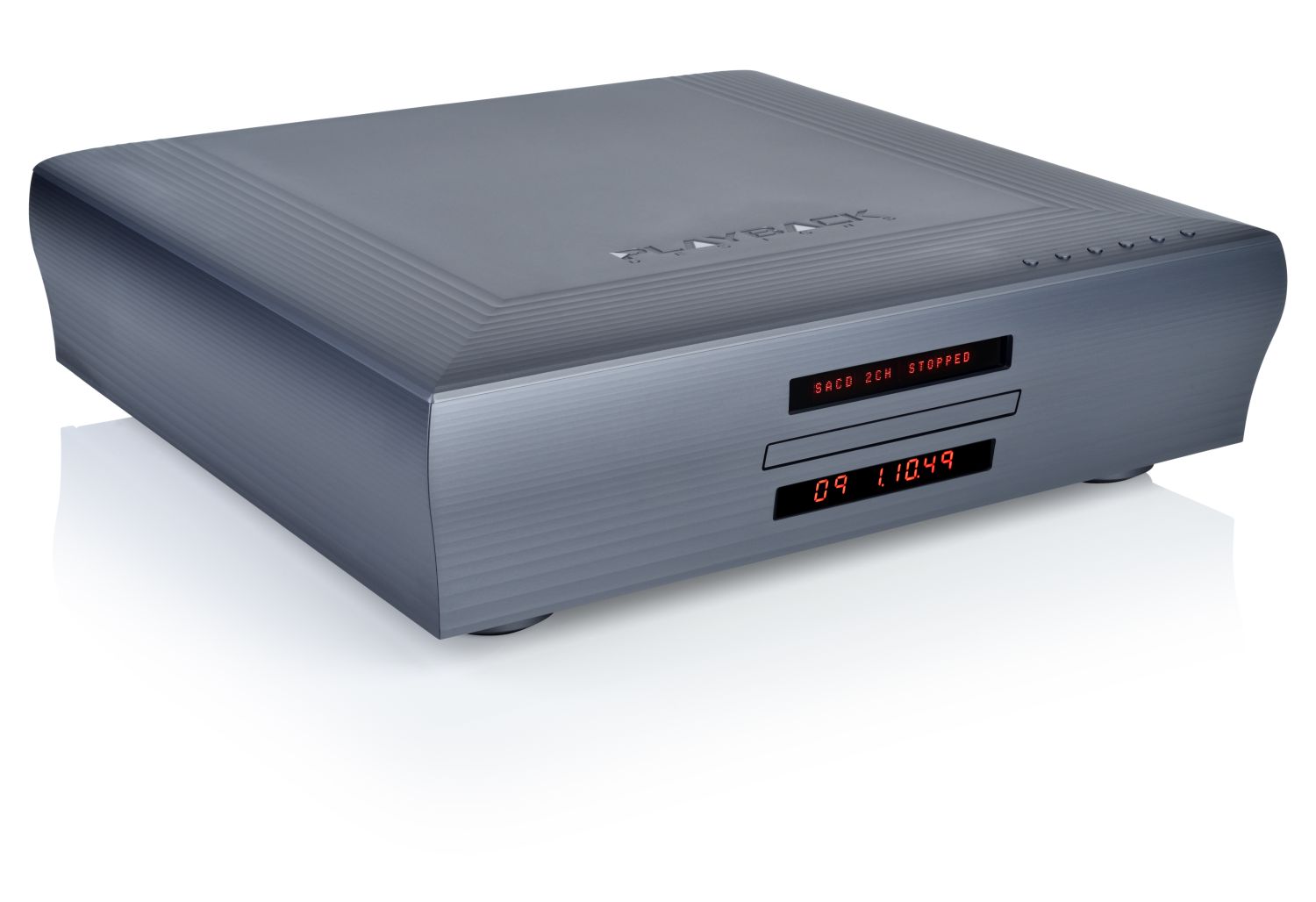







Thank you very much for this review. You continue to be, IMHO, the best audio server reviewer, able to understand and communicate the nuances of these machines, which much more difficult than it seems.
The comments of interconnects and power cables were interesting thanks.
Did the MU2 earn your recomendation?
Great review Christiaan, Question for you. Have you looked at the HiFirRose products? Specifically the 150B and the 130. I am considering the 150B. Matching it with a Bryston 4bsst, Mark Levinson 280S, balanced Cardas cables through out and a Arcam FMJ old school CD player with the Dcs ring dac vintage 2003. Love the sound looking g to progress. My sound is to my ears still excellent..obviously looking to improve however, the all in one unit goes against my audiophile instinct..Your thoughts are very much appreciated
I know of HifiRose but have yet to hear one in my system.
Thanks for the review. I have the Grimm MU1/LS1be/SB1 system. Unsurprisingly, many of your observations correspond to what I hear. It’s the first time since my KLH stereo from college days that the whole system is from 1 manufacturer. And it is quite an accomplishment.
I did read your review actually a few times,.
I have MU2 on order,.
Was surprised Not to see your endorsement for this product.
At Axpona I had dealer switching between Mola Mola T and MU2 . ( he had both connected to rh preamp ) , I could hear a slight difference between the DACs , MMT did sound like it had more authority and was but brighter .
Hope I like the sound of MU2 in my system ( Martin Logan 15a powered by Luxman M900 and MU2 ( hopefully soon )
Hi David,
Between the MU1 with Tambaqui DAC and the integrated MU2, it is a matter of convenience, value, and personal preference. The MU1 allows the user all the freedom to choose a DAC that works synergystically with the system or caters to particular listening preferences. The M2 ticks many boxes and is very cost effective considering it has not only a server and DAC, but also a preamp on board.
As balanced and objective as I try to be with my reviews, they still reflect my personal taste and that, together with the cost/performance ratio and various other factors, defines a component getting a reward or not. What I found was that the MU2’s sonic presentation deviates from the course set by the MU1, meaning that if one loves the MU1 with a given DAC, the MU2 may steer things in another direction. It is a different product, not an automatic guaranteed upgrade. As such, I personally prefer the MU1 and its digital output that allows freedom of DAC selection, and this is reflected in the review.
With all that said, I stand by what I wrote in the review and in the end, a home audition will provide definitive answers. Do let me know the results of your listening session!
Thank you , out of all MU2 reviews I found your most in depth and informative.
I’m patiently waiting for my unit to come.
Might be taken seriously when it supports Spotify Connect. Otherwise it’s misreading its already-niche “audiophile” audience. Aurender, Auralic, Lumin all support Spotify Connect.
Agreed: having more options for streaming services is always better. It’s nice to be able to choose. I use Qobuz and am very pleased with the sound quality but Spotify uses a lossy format at 320kbs, not an audiophile source, and therefore, I don’t feel it is a serious omission.
Spotify is NOT a lossy format as it’s 320kbps vorbis, not mp3 as is often misleading mistaken. Even audiophile ears would struggle to hear the diff between FLAC and Vorbis at 320kbps.
As far as I know, Vorbis is a lossy format. In any case, I’ve not yet heard Spotify sound as good as Qobuz or Tidal.
All digital formats are essentially lossy and the difference is made from LAN connection, power supply, of course the hardware of the streamer and DAC. I suspect if they get Spotify into MU3, or into MU2 via firmware, you’ll find Spotify’s MUCH larger library will sound just as good. Tidal is now around 96% of the library (but UX still sucks) and Qobuz is for very limited tastes with 40% of Spotify’s global library. Stats from Spundiiz with my own playlists — around 120,000 songs of many genres.
I carefully read your review of the MU2. This week I went to a friend who had the MU 2 in his system. He is an experienced audiophile. It has a large hall built high up. He told me that he had never heard a dac sound so good. He uses the MU2 with his pre-amp. I also liked it.
I have the INNUOS STATEMENT, with the APL DSD-SR-SE dac. How would you compare these two DAC-STREAMERs? What are their characteristics in relation to each other? Do you have a preference? You have already published an article on APL’s DSD-AR.
Thank you so much
Tough to compare and extrapolate off the top of my head, and with a server that I have never heard in a controlled environment, let alone compared to other servers. I’d be inclined to think the two may be comparable in quality although there will undoubtedly be differences. These will be of personal preference. I recommend trying it for yourself.
Goedendag
Kunt u mij een advies geven over het volgende.
Ik speel nu met een soulution 711 via een sotm ultra streamer op een msb analog dac met (goede) analoge volume regeling module op magico Q3.
De bediening van de sotm via ipeng is erg complex. Ik heb derhalve een Roon licentie genomen en dit rechtstreeks aangesloten via de V2 renderer module opi de dac. Het geluid is sindsdien erg vlak/saai geworden waardoor ik op zoek ben naar een alternatief. Ik overweeg een mu2 van Grimm maar heb twijfels of het niet beter is om bv een aurender of mu 1 te combineren met de analog dac en t.z.t. een aparte voorversterker vb een soulution 725 of ch Precision te gebruiken. Deze laatste optie lijkt me muzikaal gezien de beste echter prijzig of zou een mu2 ook deze kwaliteit geven
Mvg Ruud Warringa
Hi Ruud, as you found, Roon has a different sound than MPD and UPnP, and depending on your system and preferences, one can be preferred over the other by a significant margin. To me, Roon sounds smooth, rich, and fluid, but it is not the last word in speed, articulation, transient sharpness, and expression. However, I would not refer to Roon as “flat” so maybe there’s another culprit or something that can be done to offset the change and restore the balance. If you like the SOtM, then another remote app might be a solution. You could try Rigelian, or search for other MPD-compatible apps. Aurender also works with MPD, and their app is an adaptation of the mpad app. Between MU1 + DAC versus MU2, the latter achieves a very high quality and is cost-effective, but the former offers more freedom to choose a DAC according to your desired voicing. The preamp section of the MU2 is very transparent but no true alternative for a CH L1 or Soulution 725.
Roon’s character is audible on every server, so, if you prefer UPnP, then I recommend finding another solution. Aurender works with MPD which is typically easy to operate, and has the potential to sound close to UPnP. However, the implementation has a large impact, and I would be hard-pressed to choose between an Aurender and the MU 1 or MU2.
Hi Christiaan,
Can you please tell me who made the acoustic pannels (two grey looking blocks) you have on the front all?
Thanks.
They are Sirrahs, made by R.T.F.S. See my review.
PS: each of my reviews has an Associated Equipment link at the bottom, as well as a link to the particular composition of the system at the time of the review.
Hi Christiaan
I’m currently debating over whether to buy the MU1 or MU2. Following your review, a few questions:
1. Is the MU2 in server/streamer mode perhaps a tad politer than the MU1?
2. If a user was after an existing, toe-tapping sound, which DAC would you recommend be paired with the MU1?
3. With regards Roon, I too share your assessment of it but hasn’t Grimm worked with Roon to mitigate the software’s somewhat softer, recessed sound signature?
Any feedback gratefully received.
And thanks for all your articles and insights. I often read your site.
Hi John, thanks for the feedback, nice to hear you like my work! Although it is hard to compare a server with built-in DAC to a server with an external DAC of choice, I would indeed say the MU2 leans to the polite side. It is suggested that Grimm “worked with Roon to mitigate the software’s somewhat softer, recessed sound signature”, but I don’t believe they have tuned the server in any way. They strive for a neutral-sounding and correct-measuring performance. Nevertheless, when I first reviewed the MU1, I had a hunch that the server’s balance of hardware and software compensated for Roon’s signature, as the MU1 was the liveliest Roon server I heard, bettering even my best UPnP endpoint at that time. A few updates later, however, the MU1 sounds more refined, airier, lusher, and indeed also relatively more polite. The MU2 is brilliant in providing superb resolution in a fluid and “analog” manner, but if you want the freedom to tune the sound to your liking, the MU1 may be a better choice. Two great DACs for the MU1 are the Aqua Formula xHD and Mola Mola Tambaqui. Other DAC brands that sound exciting and toe-tapping that spring to mind are Denafrips, Laiv, COS, and dCS. The best DACs I heard, price no object, are Playback Designs and CH Precision.
Thank you. While the MU1 provides some tuning flexibility (with a separate DAC), I may now look at alternative servers/streamers that don’t rely solely on Roon (despite the recent update that claimed to improve SQ). The LinQ is one. And thanks for the DAC recommendations. The Laiv is an interesting option: some reviews say it’s laid-back and warm, others say it’s exciting and energetic. Maybe it’s both.
Hi John, FWIW, I would describe the Laiv Harmony DAC as neither warm nor laidback. Ultimately, your own ears should be the judge:-)